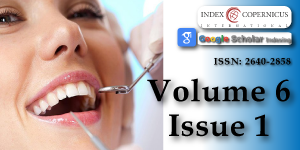Establishment of soft tissue norms for sagittal discrepancy for maxilla and mandible in central Gujarat population
Main Article Content
Abstract
Objective: To establish the cephalometric norms of ‘Zero meridian line’ and ‘Mew line’ to assess the sagittal discrepancy in the maxilla and mandible of subjects in the Central Gujarat population
Materials and methods: The sample was screened from the records from the hospital. 100 individuals (50 males, 50 females) of the age group between 18-50 years, native of Central Gujarat, with acceptable pleasing profile, no skeletal asymmetry, normal Class I occlusion having ideal anterior bite, less than 2 mm crowding and no history of previous orthodontic treatment were selected for the study. Lateral cephalograph were taken in natural head position. The linear measurements between points of soft tissue pogonion to the Zero Meridian line (vertical line dropped from soft tissue nasion) and distance of Mew line (the biting edge of the upper front teeth to the tip of the nose) was taken on cephalograms.
Result: Mean value for soft tissue pogonion to the Zero meridian line on cephalograms was 0.2 mm for female and 0.8 mm for male and mean value for Mew line on cephalograms was 39 mm for female and 42 mm for male subjects.
Conclusion: Normal value for soft tissue pogonion to the Zero meridian line is 0.8 + 1.8 mm for males and 0.2 + 1.7 mm for females, and normal value for Mew line is 41.2 + 3.2 mm for male and 39.4 + 2.2 mm for female in Central Gujarat population. Values other than normal suggests skeletal sagittal discrepancy of maxilla and/or mandible, which is helpful in diagnosis and treatment planning.
Article Details
Copyright (c) 2022 Virani K, et al.

This work is licensed under a Creative Commons Attribution 4.0 International License.
Ishikawa H, Nakamura S, Iwasaki H, Kitazawa S. Seven parameters describing anteroposterior jaw relationships: Post pubertal prediction accuracy and interchangeability. Am J Orthod Dentofacial Orthop. 2000; 117:714‑720.
Baik CY, Ververidou M. A new approach of assessing sagittal discrepancy: The Beta angle. Am J Orthod Dentofacial Orthop. 2004; 126: 100‑105.
Broadbent BH. A new x‑ray technique and its application to orthodontia. Angle Orthod. 1931; 1:45‑66.
Downs WB. Analysis of the dentofacial profile. Angle Orthod. 1956; 26:191‑212.
Steiner CC. Cephalometrics for you and me. Am J Orthod.1953; 39:729‑755.
Tweed CH. Evolutionary trends in orthodontics, past, present and future. Am J Orthod. 1953; 39:81‑108.
Tweed CH. The Fränkfort‑mandibular incisor angle [FMIA] in orthodontic diagnosis, treatment planning and prognosis. Angle Orthod. 1954; 24:121‑69.
Ricketts RM, Schulhof RJ, Bagha L. Orientation-sella-nasion or Frankfort horizontal. Am J Orthod. 1976 Jun;69(6):648-54. doi: 10.1016/0002-9416(76)90147-0. PMID: 1064336.
Ricketts RM. Perspectives in the clinical application of cephalometrics. The first fifty years. Angle Orthod. 1981 Apr;51(2):115-50. doi: 10.1043/0003-3219(1981)051<0115:PITCAO>2.0.CO;2. PMID: 6942666.
Jacobson A. The “Wits” appraisal of jaw disharmony. Am J Orthod. 1975; 105: 328‑344.
Jacobson A. Application of the "Wits" appraisal. Am J Orthod. 1976 Aug;70(2):179-89. doi: 10.1016/s0002-9416(76)90318-3. PMID: 1066054.
Coben SE. The integration of facial skeletal variants. Am J Orthod. 1955; 41: 407‑434.
Wylie WL. The assessment of anteroposterior dysplasia. Angle Orthod. 1947; 7: 97‑109.
Sassouni V. A classification of skeletal facial types. Am J Orthod. 1969 Feb;55(2):109-23. doi: 10.1016/0002-9416(69)90122-5. PMID: 5249177.
Sassouni V. The Class II syndrome: differential diagnosis and treatment. Angle Orthod. 1970 Oct;40(4):334-41. doi: 10.1043/0003-3219(1970)040<0334:TCISDD>2.0.CO;2. PMID: 5272409.
Enlow DH, Moyers RE, Hunter WS, McNamara JA Jr. A procedure for the analysis of intrinsic facial form and growth. An equivalent-balance concept. Am J Orthod. 1969 Jul;56(1):6-23. doi: 10.1016/0002-9416(69)90254-1. PMID: 5255278.
Bimler HP. The Bimlercephalometric analysis. Germany: Wiesbaden; 1973.
Beatty EJ. A modified technique for evaluating apical base relationships. Am J Orthod. 1975 Sep;68(3):303-15. doi: 10.1016/0002-9416(75)90238-9. PMID: 1057851.
Di Paolo RJ, Philip C, Maganzini AL, Hirce JD. The quadrilateral analysis: an individualized skeletal assessment. Am J Orthod. 1983 Jan;83(1):19-32. doi: 10.1016/0002-9416(83)90267-1. PMID: 6571768.
Williams S, Leighton BC, Nielsen JH. Linear evaluation of the development of sagittal jaw relationship. Am J Orthod. 1985 Sep;88(3):235-41. doi: 10.1016/s0002-9416(85)90218-0. PMID: 3862346.
Yang SD, Suhr CH. F-H to AB plane angle (FABA) for assessment of anteroposterior jaw relationships. Angle Orthod. 1995;65(3):223-31; discussion 232. doi: 10.1043/0003-3219(1995)065<0223:FTAPAF>2.0.CO;2. PMID: 7639436.
Nanda RS, Merrill RM. Cephalometric assessment of sagittal relationship between maxilla and mandible. Am J Orthod Dentofacial Orthop. 1994 Apr;105(4):328-44. doi: 10.1016/s0889-5406(94)70127-x. PMID: 8154458.
González-Ulloa M, Stevens E. The role of chin correction in profileplasty. Plast Reconstr Surg. 1968 May;41(5):477-86. doi: 10.1097/00006534-196805000-00010. PMID: 5652638.
Naini FB. Facial aesthetics: Concepts and clinical diagnosis. 1st ed. Oxford: Wiley-Blackwell. 2011; 71-85.
Mew J. Use of the 'indicator line' to assess maxillary position. Funct Orthod. 1991 Jan-Feb;8(1):29-32. PMID: 1937156.
Ricketts R M. The biological significance of the Devine Proportion and Fibonacci series. Am J Orthod. 1982; 81: 351-70.
Moss JP, Linney AD, Lowey MN. The use of three-dimensional techniques in facial esthetics. Semin Orthod. 1995 Jun;1(2):94-104. doi: 10.1016/s1073-8746(95)80096-4. PMID: 8935048.
Platou C, Zachrisson BU. Incisor position in Scandinavian children with ideal occlusion. A comparison with the Ricketts and Steiner standards. Am J Orthod. 1983 Apr;83(4):341-52. doi: 10.1016/0002-9416(83)90231-2. PMID: 6573148.
Kerr WJ, Ford I. A comparison of facial form in three Western European male groups. Eur J Orthod. 1986 May;8(2):106-11. doi: 10.1093/ejo/8.2.106. PMID: 3459661.
Kitafusa, Y: Changing Occlusal Patterns and the Indicator Line in Extraction and NonExtraction Treatment. Eur J Orthod. 2001; 24: 568.
Vinay K., Shobha S. Cephalometric Assessment of Sagittal Dysplasia: A review of Twenty-one methods. J Ind Orthod Soc. 2014; 48: 33-41.
Akhilesh B., Deepti D., Vinay D. Determining the sagittal relationship between the maxilla and mandible by Cannons analysis in Chhattisgarh population. National J of Medical and dental Research. 2017; 6: 33-318.
Ahmed M, Shaikh A, Fida M. Diagnostic validity of different cephalometric analyses for assessment of the sagittal skeletal pattern. Dental Press J Orthod. 2018 Sep-Oct;23(5):75-81. doi: 10.1590/2177-6709.23.5.075-081.oar. PMID: 30427496; PMCID: PMC6266314.
Adeel A B, Chauhan A K, Anil S, Santosh K. Cephalometric analysis for assessing sagittal jaw relationship- A comparative study. Ind J Orthod Dento Research. 2021; 7:150-159

